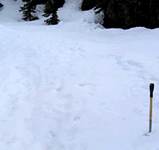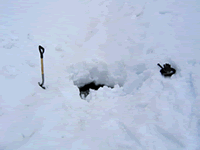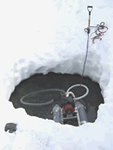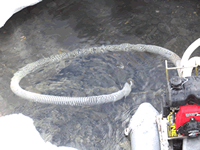Spring 2007 Tincan Creek
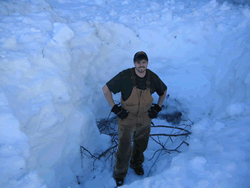
The spring started off with a bit of a challenge this year. I was planning to pull out the 6 inch dredge in the fall of 2006 before the real snow began to fly and didn't quite make the deadline. This was partly due to my own poor planning, and partly due to a really good day of dredging. I had discovered a nice pay streak in the early fall when the water clarity was extremely poor from glacial silt. On the day I was planning to remove the dredge from the creek, the temperature had dropped enough to make the creek water crystal clear.
When I arrived at the dredge I was able to see that what I thought was bedrock was actually a large flat rock. Having a bit of fuel left for the dredge & decided to see what was actually on the bedrock lying under the large slab of rock I had uncovered previously. After removing the slab of rock I found a good size crevice in the bedrock going down almost another 3 1/2 feet. Once I got to the bottom I picked up an easy 1/2 ounce of nice little earring size nuggets! This all took about 30 minutes once I started the dredge. I used a pair of tweezers to dislodge some of the nuggets wedged into the tiny cracks in the bedrock. As soon as I had uncovered the gold, I ran out of gas.....go figure. This is why I decided to delay in pulling out our dredge. My brilliant plan was to return to Anchorage for fuel, and come back the next day to harvest more gold!
Much to my disappointment the temperatures dropped rapidly freezing the creek solid with the dredge still in it. Sarah and I returned the following day to find ice had crept up both sides of our dredge and encased all but the engines in ice! We were not able to free the dredge & decided to pull the engines & return to get the rest of the dredge when it thawed out a bit.
That turned out to be spring 2007. After digging for a day and a half I finally found the rope that secured the dredge to a tree!
When I arrived at the dredge I was able to see that what I thought was bedrock was actually a large flat rock. Having a bit of fuel left for the dredge & decided to see what was actually on the bedrock lying under the large slab of rock I had uncovered previously. After removing the slab of rock I found a good size crevice in the bedrock going down almost another 3 1/2 feet. Once I got to the bottom I picked up an easy 1/2 ounce of nice little earring size nuggets! This all took about 30 minutes once I started the dredge. I used a pair of tweezers to dislodge some of the nuggets wedged into the tiny cracks in the bedrock. As soon as I had uncovered the gold, I ran out of gas.....go figure. This is why I decided to delay in pulling out our dredge. My brilliant plan was to return to Anchorage for fuel, and come back the next day to harvest more gold!
Much to my disappointment the temperatures dropped rapidly freezing the creek solid with the dredge still in it. Sarah and I returned the following day to find ice had crept up both sides of our dredge and encased all but the engines in ice! We were not able to free the dredge & decided to pull the engines & return to get the rest of the dredge when it thawed out a bit.
That turned out to be spring 2007. After digging for a day and a half I finally found the rope that secured the dredge to a tree!
Well, that was a good lesson anyway. I Should have listened to Sarah! There was still too much ice covering the creek and dredge to free it at the time of the photo. After locating the rope I had to follow it downstream to the dredge. It took another week to dig though all the snow and actually retrieve the dredge. I must say I was nicely surprised to find it had survived quite well, preserved in ice!
So, with much of the best part of the spring mining season slipping away I decided to bring in our small 2 1/2 inch dredge to sampling. In march the water is just beginning to flow under the ice on our claims and it makes for optimal dredging conditions.
The creek was still covered with about 4 feet of snow so I started off by looking for sunken areas to dig for the creek. Using a shovel it took a few minutes of digging to punch through to running water.
So, with much of the best part of the spring mining season slipping away I decided to bring in our small 2 1/2 inch dredge to sampling. In march the water is just beginning to flow under the ice on our claims and it makes for optimal dredging conditions.
The creek was still covered with about 4 feet of snow so I started off by looking for sunken areas to dig for the creek. Using a shovel it took a few minutes of digging to punch through to running water.
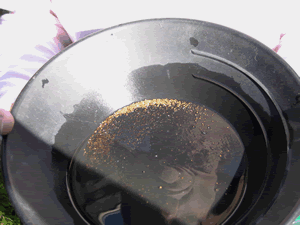
I dredged for a few hours & found some match head size nuggets & a few decent flakes. It was not nearly as good as what I had been finding the previous fall. I was not able to get back into that area since there was simply too much snow pack, and an ice layer about 6 inches thick still covered the creek in that spot.
With the sun low on the horizon it was cooling down fast & I decided to call it a day. I was happy I had discovered some color in a new spot & wondered what might be found if the hole was opened up a bit more. That would have to wait for another trip. It was still a 20 minute snow shoe hike out of the canyon, so off I went.
The following day I ran the concentrates from the dredge through a Gold wheel to separate the gold from the black sands. The wheel uses gravity and water flow to wash away lighter material from the gold. It's an environmentally friendly (no chemicals) way of recovering the really small gold dust from the concentrated black sand. This is gold recovered using a Gold wheel. The red is iron pyrite. The only draw back to using a wheel is that it is a slow process. If your trying to recover fine gold, you never want to get in a hurry.
It was a few days before I made it back out to the creek. I decided to hike up the canyon and try my luck at metal detecting. I'm not too good at it as I have spent most of my time digging or dredging. I had used an older detector years ago that had no way to discriminate between iron & gold. I lost interest after digging up about a thousand pieces of trash. Newly armed with a Whites GMT detector I purchased from Alaska Mining and Diving I thought I'd try it again.
One thing nice about the spring in Alaska is that the ground is not covered with vegetation. I was able to find a lot of open ground that is usually overgrown in the summer. The snow also allows areas to be accessed that are otherwise not.
With the sun low on the horizon it was cooling down fast & I decided to call it a day. I was happy I had discovered some color in a new spot & wondered what might be found if the hole was opened up a bit more. That would have to wait for another trip. It was still a 20 minute snow shoe hike out of the canyon, so off I went.
The following day I ran the concentrates from the dredge through a Gold wheel to separate the gold from the black sands. The wheel uses gravity and water flow to wash away lighter material from the gold. It's an environmentally friendly (no chemicals) way of recovering the really small gold dust from the concentrated black sand. This is gold recovered using a Gold wheel. The red is iron pyrite. The only draw back to using a wheel is that it is a slow process. If your trying to recover fine gold, you never want to get in a hurry.
It was a few days before I made it back out to the creek. I decided to hike up the canyon and try my luck at metal detecting. I'm not too good at it as I have spent most of my time digging or dredging. I had used an older detector years ago that had no way to discriminate between iron & gold. I lost interest after digging up about a thousand pieces of trash. Newly armed with a Whites GMT detector I purchased from Alaska Mining and Diving I thought I'd try it again.
One thing nice about the spring in Alaska is that the ground is not covered with vegetation. I was able to find a lot of open ground that is usually overgrown in the summer. The snow also allows areas to be accessed that are otherwise not.
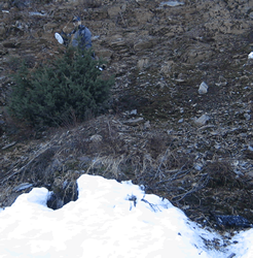
I'd checked a few areas with the detector but was not able to find gold. This was probably due to my in-experience using the equipment.
I must say the detector is quite impressive being sensitive enough to pick up tiny gold flakes and even minute pieces of aluminum foil. I learned a lot about metal detecting from reading Steves Herschbach's mining Journal off the Alaska mining And Diving website. There you can read & learn so much from his incredible mining trips.
I had hiked quite a ways into the back country and decided it was time to call it quits. I would return another time, perhaps after I was more experienced with the detector.
This pretty well summed up our spring. Within a few weeks we had our 6 inch dredge dug out of the snow and ready for the season, the real runoff had already started. This brought the creek to flood level. It was late June before we were able to get any kind of dredging done.
I will try & get more of our trips posted online as time permits. Thanks for reading, and Happy Prospecting!
I must say the detector is quite impressive being sensitive enough to pick up tiny gold flakes and even minute pieces of aluminum foil. I learned a lot about metal detecting from reading Steves Herschbach's mining Journal off the Alaska mining And Diving website. There you can read & learn so much from his incredible mining trips.
I had hiked quite a ways into the back country and decided it was time to call it quits. I would return another time, perhaps after I was more experienced with the detector.
This pretty well summed up our spring. Within a few weeks we had our 6 inch dredge dug out of the snow and ready for the season, the real runoff had already started. This brought the creek to flood level. It was late June before we were able to get any kind of dredging done.
I will try & get more of our trips posted online as time permits. Thanks for reading, and Happy Prospecting!

